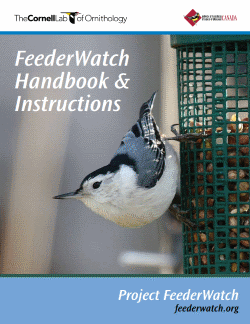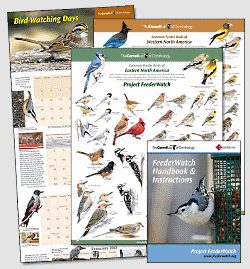

Courtesy Project Feederwatch, Cornell Lab of Ornithology
Observation sites can be as large as two tennis courts, or as small as a single feeder. Make sure the site is easily seen through your windows, then just use that same site all season. You simply observe the birds that come to that site for two consecutive days each week. And your counting time can be less than an hour, or more than eight hours, depending on your personal choices.
The scientists want data collected only during winter months, so in 2018 the reporting time ends April 13.
Record and report the largest number of each species you see at any one time during the two days to avoid double-counting birds.
When the observation season is completed, you can learn the numbers and distribution of various species and see how your yard compared to others who have been observing throughout the United States and Canada.
A couple of tips to get you started: Place your feeder in a quiet area where they are easy to see and fill. It is best to have them around 10 feet from natural cover such as trees and shrubs. This provides them cover and discourages cats and squirrels from leaping to the feeders. Buy fairly large feeders so you don’t have to fill them so often. The best all-around attractant is black-oil sunflower seeds due to its high fat content and it is easy for small birds to handle and crack open. Suet, or cakes of beef fat containing a variety of seeds, is another great choice for attracting insect-eating birds such as woodpeckers, chickadees, and nuthatches. The cakes are placed in small cages to hold the suet while birds enjoy the feast. If you can provide grit (sand, very small pebbles, or ground eggshells) the birds will appreciate it since they use that in their gizzard to basically “chew” the seeds. Water is essential for birds even in winter, but you may need to provide a birdbath heater to keep ice from forming. And NEVER use anti-freeze since it is poisonous to ALL animals. Keep your cat indoors. You can also prevent birds crashing into windows by breaking up the reflections on the glass with netting or other decorations.
And if, one day, while you’re enjoying a melodious chorus of bird songs that suddenly go silent, you may have a visiting Cooper’s or Sharp-Shinned Hawk hunting for lunch.
For more information, and how to register, go to feederwatch.org
This is Ron Hellstern and I’m Wild About Utah!
Credits:
Images: Courtesy & Copyright Project Feederwatch, feederwatch.org
Audio: Courtesy and Copyright Kevin Colver
Text: Ron Hellstern, Cache Valley Wildlife Association
Additional Reading
Project Feederwatch, Cornell Lab of Ornithology, https://feederwatch.org/
Feederwatch Handbook & Instructions, Project Feederwatch, Cornell Lab of Ornithology, https://feederwatch.org/wp-content/uploads/2016/11/Handbook.pdf
Instruction summary, Project Feederwatch, Cornell Lab of Ornithology, https://feederwatch.org/about/how-to-participate/instructions/
Detailed Instructions, Project Feederwatch, Cornell Lab of Ornithology, https://feederwatch.org/about/detailed-instructions/
HOMESCHOOLER’S GUIDE TO PROJECT FEEDERWATCH, Cornell Lab of Ornithology, https://www.birdsleuth.org/398/
Beyond Penquins and Polar Bears, College of Education and Human Ecology, The Ohio State University, Funded by NSF, February 2009, https://beyondpenguins.ehe.osu.edu/issue/arctic-and-anarctic-birds/project-feederwatch-integrating-real-time-science-and-math
